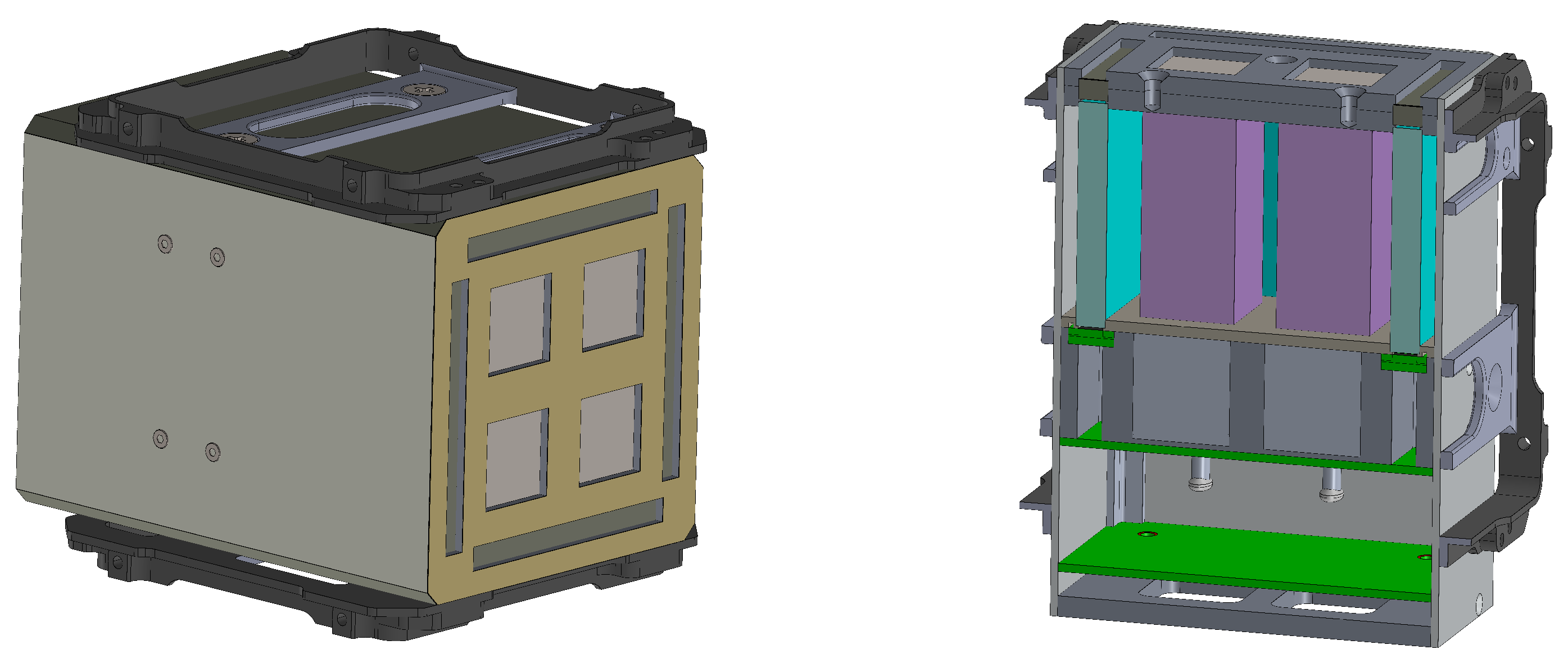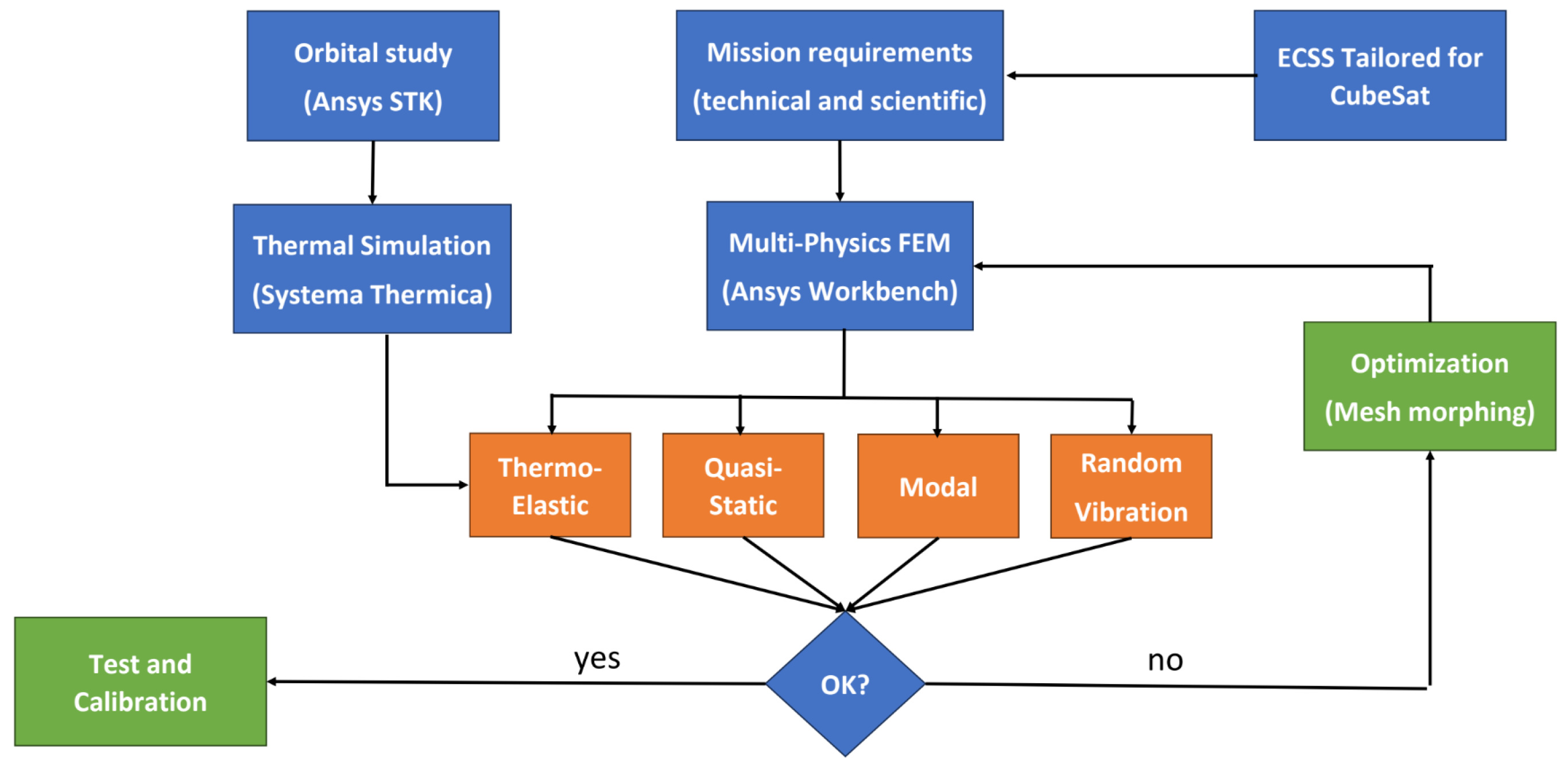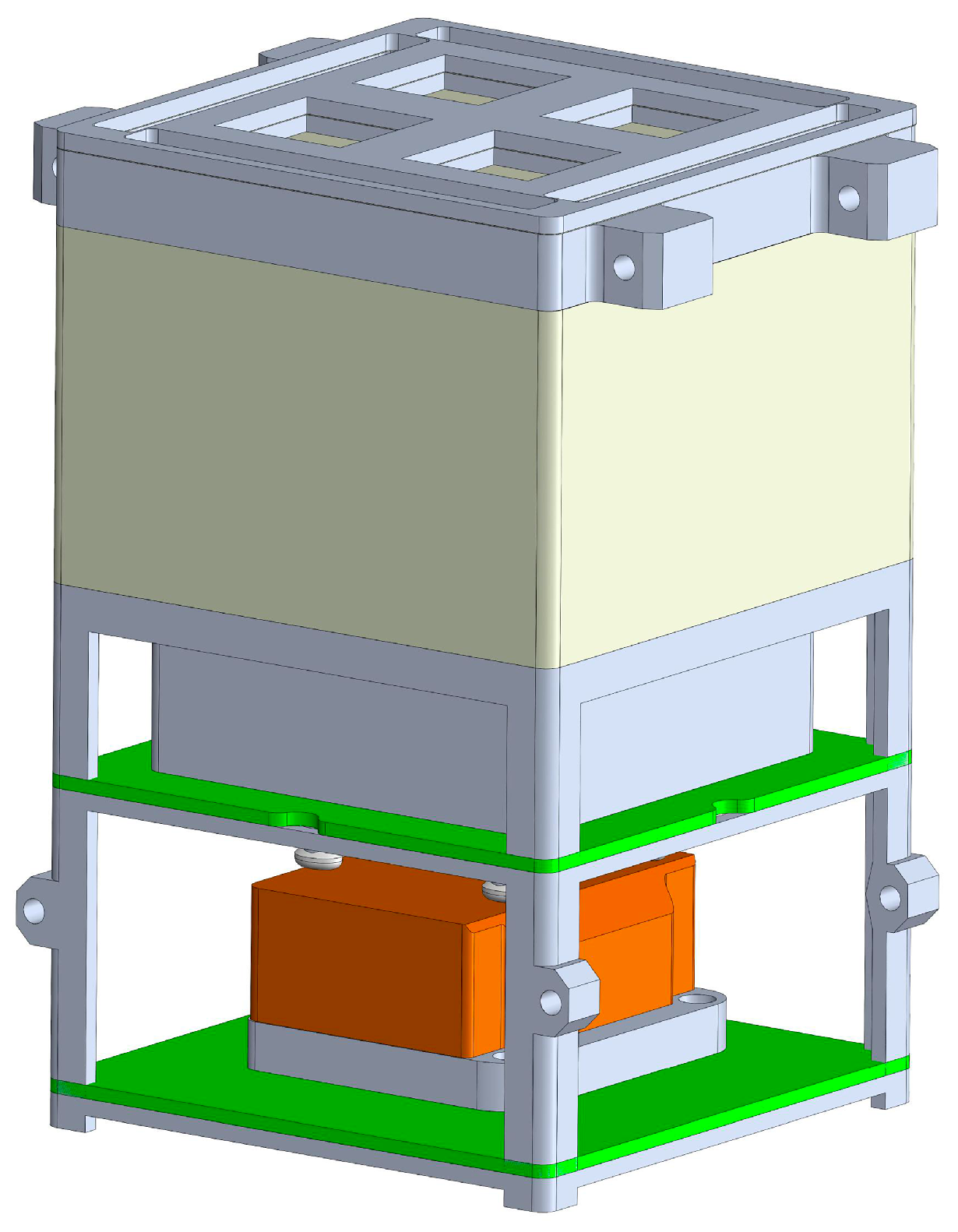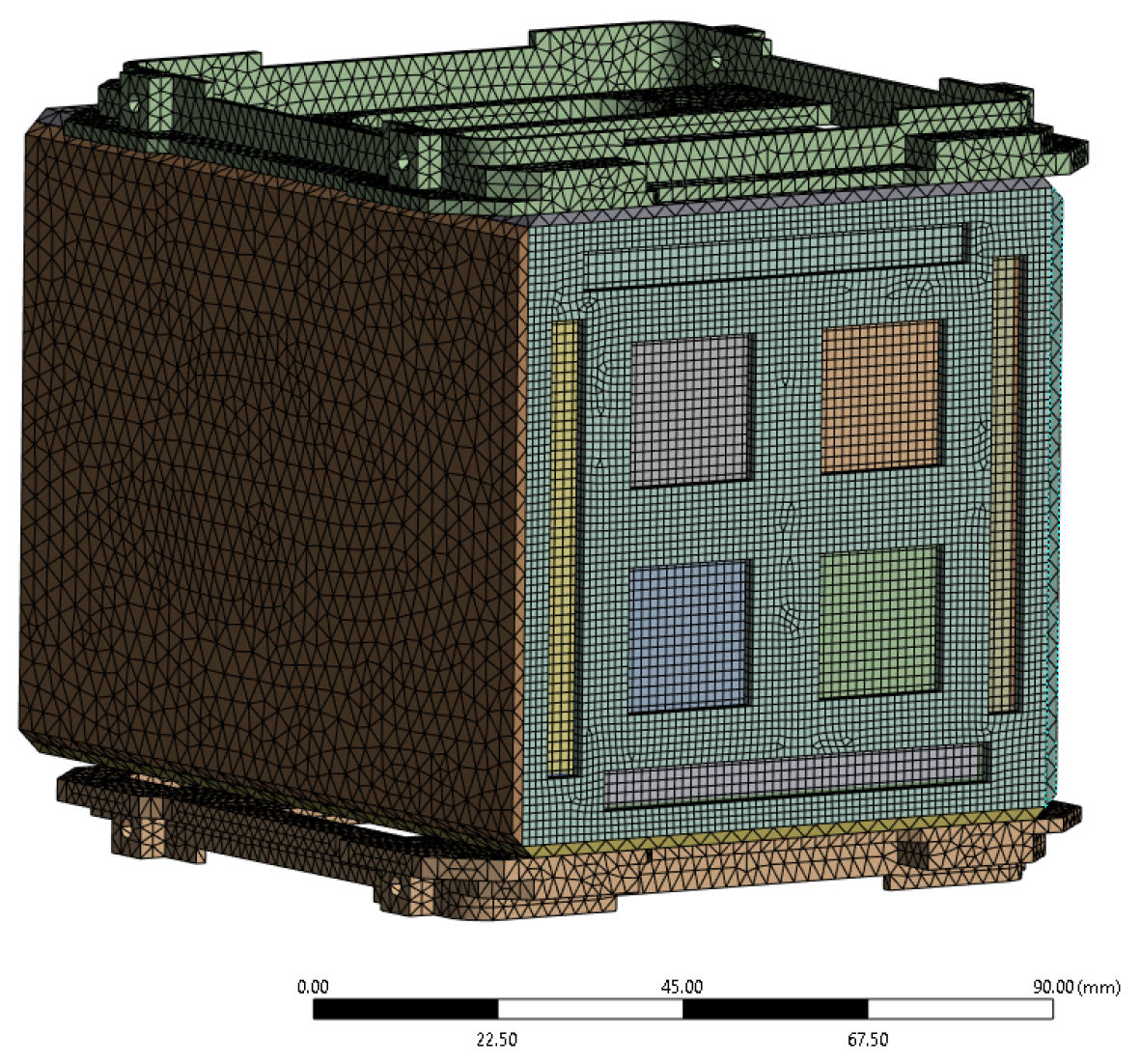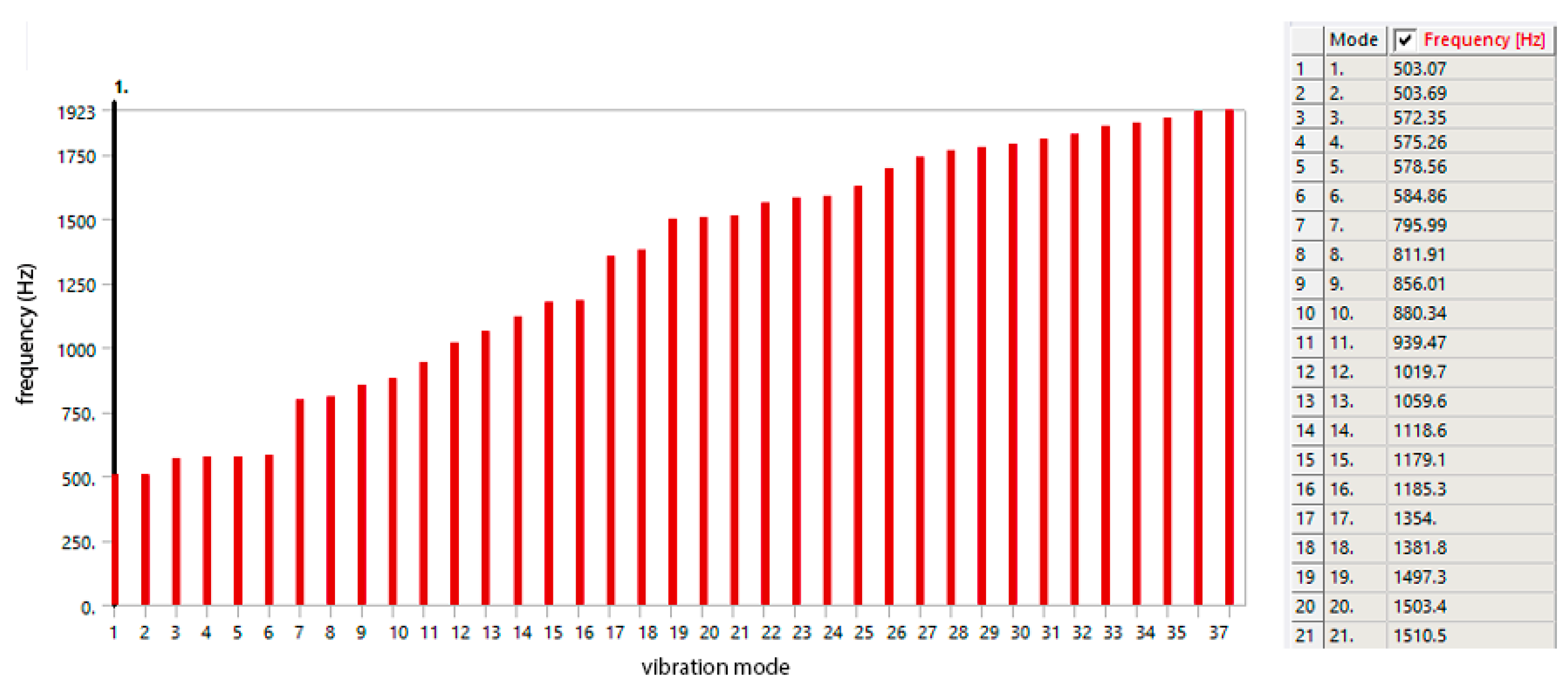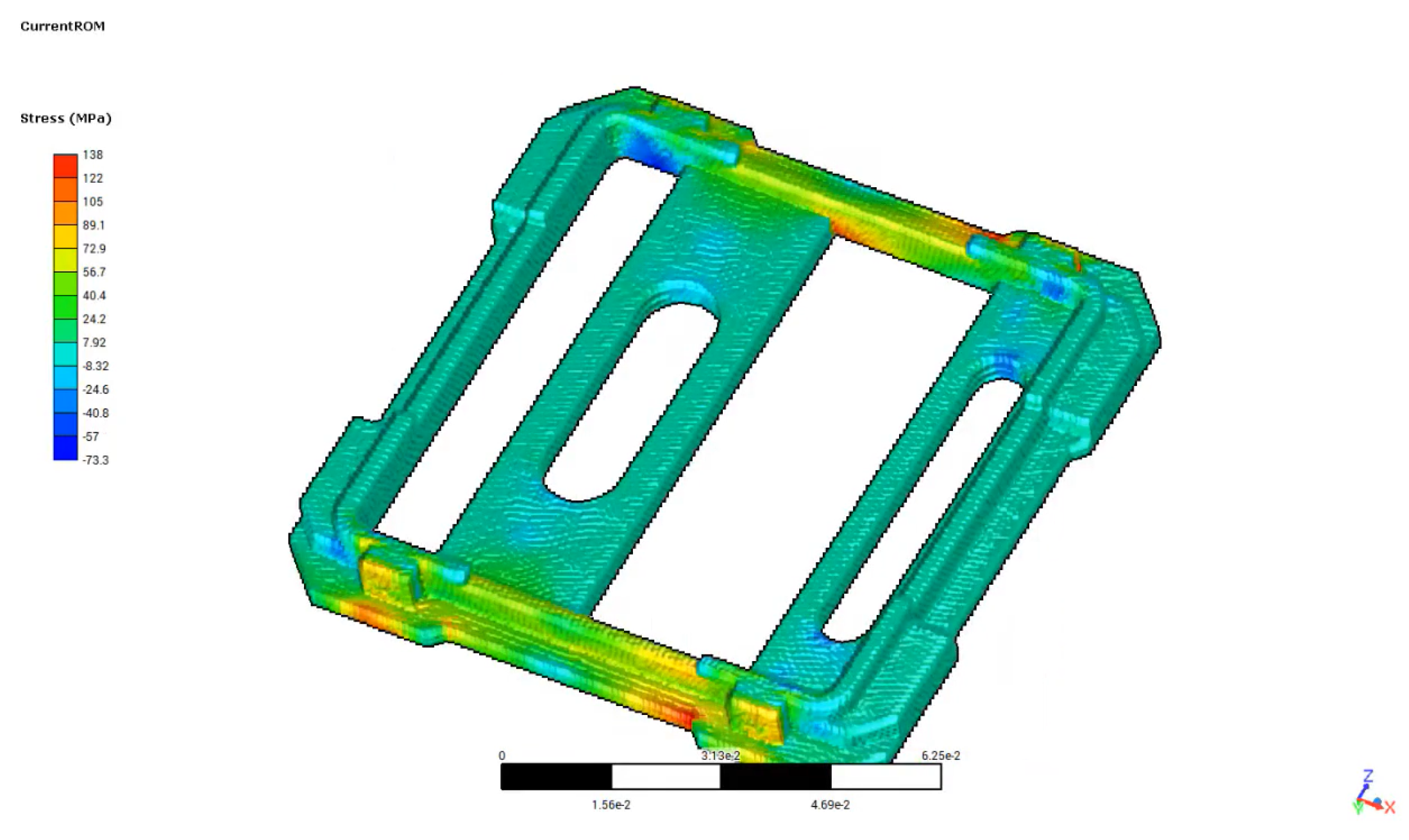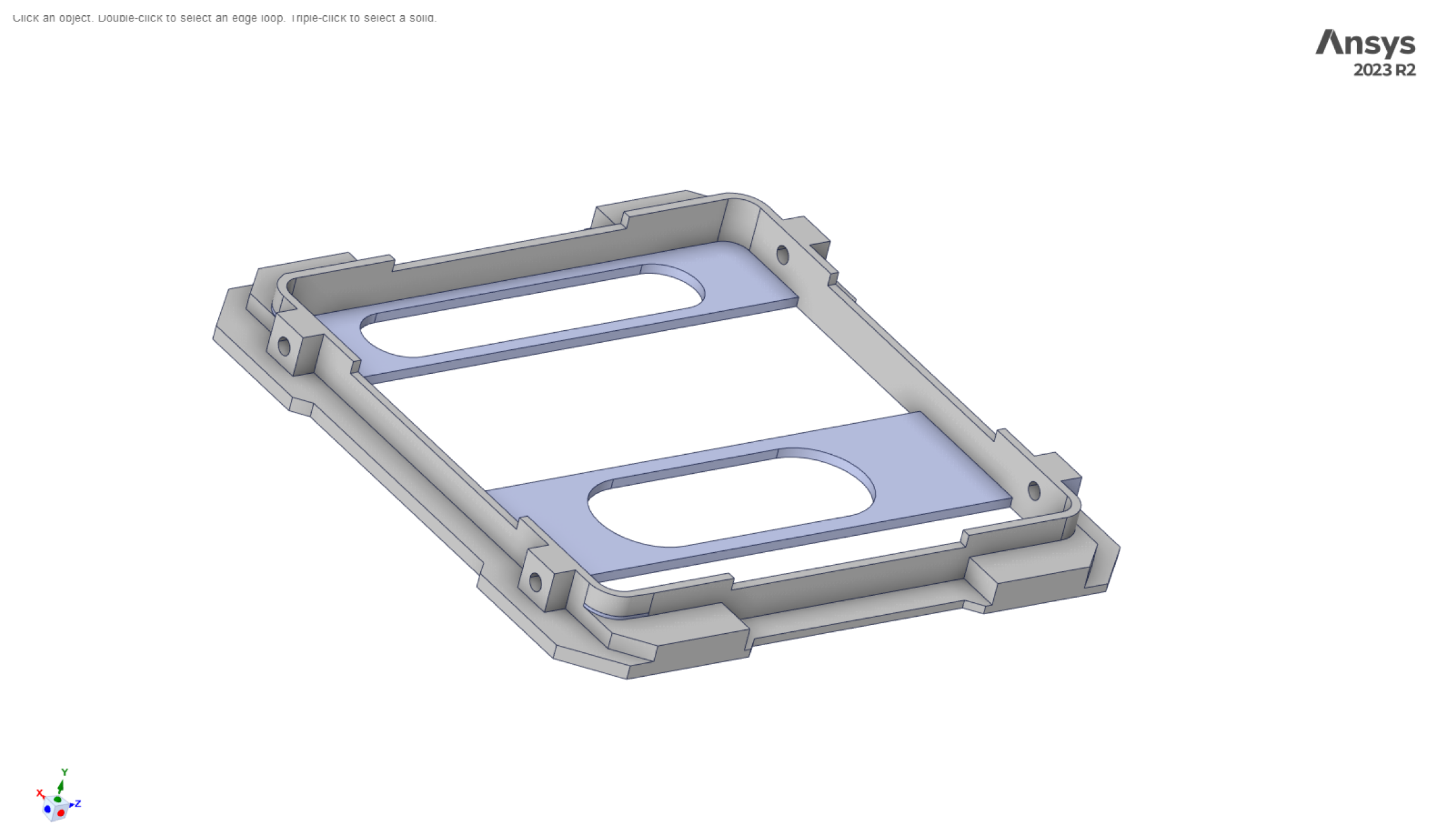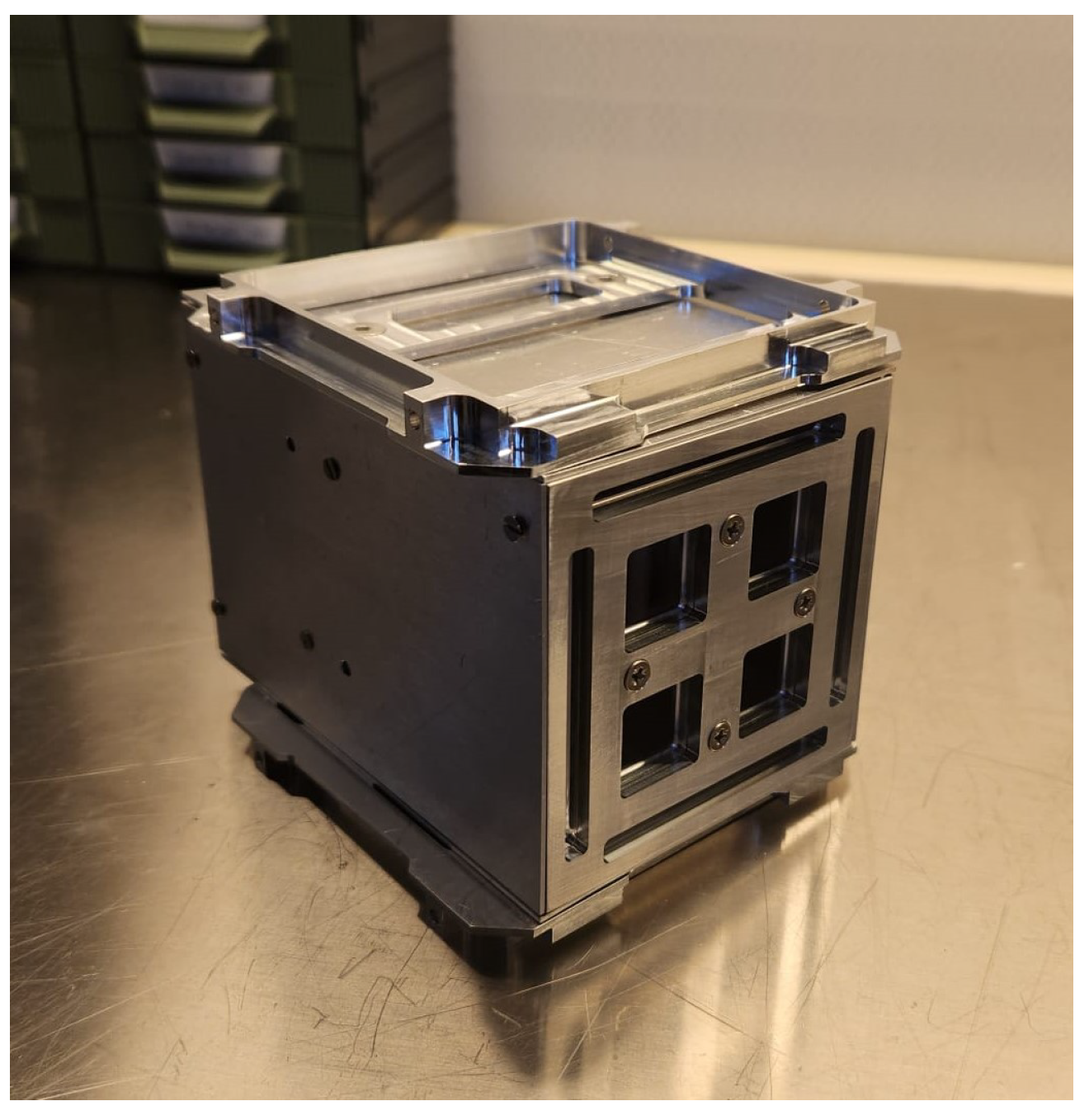1. Introduction
The
CUbesat Solar Polarimeter (CUSP) [
1] is a CubeSat mission in low Earth orbit, specifically conceived to measure the linear polarization of solar flares in the hard X-ray range (25–100 keV) through a Compton scattering polarimeter. This cutting-edge mission is expected to provide new insights into magnetic reconnection and particle acceleration mechanisms occurring within the Sun’s flaring magnetic structures, which are crucial processes underlying space weather dynamics.
Hard X-ray polarimetry offers a unique observational window into the physical mechanisms responsible for particle acceleration, as well as the temporal evolution of magnetic configurations during solar flares. These data are essential for refining current models of solar activity and understanding its influence on the heliosphere. Such improved knowledge will contribute to the development of more accurate space weather predictions, which are essential to mitigate the risks for satellite systems, communication infrastructures, and terrestrial power grids.
CUSP is developed within the framework of the
Alcor Program, a strategic initiative led by the Italian Space Agency (ASI) to promote innovative CubeSat missions. Having been approved for
Phase B in 2024 [
2], the CUSP project embraces an innovative design methodology, incorporating
Reduced-Order Models (ROMs) and
Radial Basis Function (RBF) mesh morphing techniques to optimize the payload design. These approaches enable real-time predictions of critical physical quantities, such as stress and thermal distributions, thereby enhancing the overall design efficiency and robustness.
This paper presents the preliminary design solutions proposed for the CUSP payload, with a focus on the multiphysics analyses and the topology optimization performed on key structural elements. Advanced numerical methods have been employed to lay the groundwork for future developments in CubeSat payload engineering.
The paper is structured as follows: Section Theoretical background provides the theoretical background, including the implementation of ROM and RBF techniques; Section Workflow and Software describes the design workflow and software tools adopted; Section Payload Design focuses on the payload design strategy; Section Results and Proposal presents the results of the multiphysics simulations; and finally, Section Conclusions summarizes the conclusions and outlines future activities.
2. Theoretical Background
The implementation of Reduced-Order Models (ROM) in computational analysis follows a structured and systematic workflow. The process begins with the simulation of a full-order baseline model, which serves as a reference case. Key geometrical and physical parameters influencing system behavior are identified and subsequently parametrized to enable the generation of a Design of Experiments (DoE), which spans a representative set of design points. The resulting dataset forms the basis for ROM construction.
ROMs provide efficient yet accurate representations of system behavior across the parameter space, offering substantial advantages for design optimization and real-time analysis. In parallel, Response Surface Methodology (RSM) is employed to construct statistical surrogate models relating input parameters to output responses, enabling rapid, single-point optimization. While RSM focuses on localized parameter tuning, ROMs capture the global system response over a broader range of operating conditions.
A critical requirement for ROM generation is the preservation of mesh topology across all analyzed configurations. To satisfy this condition, mesh morphing techniques are applied to vary the geometry while maintaining the underlying connectivity of nodes and elements. In this work, Radial Basis Functions (RBFs) are used to interpolate nodal displacements, ensuring smooth shape updates without requiring complete mesh regeneration.
2.1. RBF Mesh Morphing
Mesh morphing is a well-established computational technique in finite element analysis (FEA), enabling the modification of an existing computational mesh to accommodate changes in geometry. Unlike traditional parametric CAD-driven approaches, which require remeshing for each new geometry, mesh morphing directly manipulates the mesh itself. This technique offers two significant advantages: (i) enhanced control over mesh quality and element distortion, and (ii) reduced computational cost, particularly when exploring design alternatives through DoE-based optimization.
The primary goal of mesh morphing is to preserve both mesh quality and connectivity while adapting the geometry to new configurations. This aspect is particularly critical when building ROMs, as maintaining node numbering and connectivity across all variants is essential for consistent model reduction.
In this study, RBF-based morphing is employed. RBFs interpolate a scalar function, defined at discrete source points, across the entire computational domain. The displacement field
is defined as:
where
N denotes the number of source points,
are the interpolation weights,
represents the selected radial basis function,
is the position vector of a generic mesh point,
identifies the coordinates of the
i-th source point, and
is a polynomial correction term whose order depends on the specific basis function.
2.2. Model Order Reduction (MOR)
Model Order Reduction (MOR) techniques are mathematical tools designed to reduce the dimensionality of complex systems while preserving their essential dynamic characteristics. Several approaches exist, including Center Manifold, Lyapunov-Schmidt (L-S), Galerkin projection, and Proper Orthogonal Decomposition (POD). Among these, POD is widely adopted for constructing ROMs in FEA due to its computational efficiency and its ability to capture dominant spatial patterns.
POD-based ROM development follows a well-defined sequence of steps. Full-order simulations are first performed at selected design points, generating a set of system state snapshots (e.g., displacement, stress, or temperature fields). These snapshots are assembled into a snapshot matrix
, where each column corresponds to a single system state. The matrix is then subjected to Singular Value Decomposition (SVD):
where:
is the snapshot matrix, with m representing the number of degrees of freedom (DOFs) and n the number of collected snapshots;
is a matrix of orthonormal left singular vectors, representing the dominant spatial modes;
is a diagonal matrix containing singular values in descending order, indicating the relative importance of each mode;
contains the right singular vectors.
By truncating the decomposition and retaining only the most relevant modes (those associated with larger singular values), a reduced-order approximation is obtained. This reduced basis preserves the key physical features of the original system while dramatically lowering computational cost.
2.3. Design of Experiments (DoE) and Response Surface Methodology (RSM)
Design of Experiments (DoE) is a statistical framework used to systematically explore the relationships between input parameters and system responses. By carefully selecting a reduced set of simulations, DoE maximizes the information extracted while minimizing computational expense. Common DoE techniques include Full Factorial (FF), Central Composite Design (CCD), and Latin Hypercube Sampling (LHS), each offering specific advantages depending on the complexity and dimensionality of the design space.
Response Surface Methodology (RSM) complements DoE by constructing surrogate models—continuous approximations of the input-output relationship—based on the sampled data. These response surfaces enable rapid evaluation of system performance at arbitrary parameter combinations, facilitating fast optimization. Various techniques can be applied to construct response surfaces, including second-order polynomial regression, Kriging, non-parametric regression, and sparse grid interpolation.
In this work, a Genetic Aggregation Response Surface (GARS) technique is applied. This method combines multiple individual response surfaces into a single composite model using a Multi-Objective Genetic Algorithm (MOGA). The aggregated response surface
is computed as:
where
denotes the individual response surfaces, and
are the weights optimized through MOGA to minimize prediction error and maximize fidelity to the training data.
The optimization workflow integrates DoE for initial sampling, RSM for surrogate modeling, and genetic algorithms for multi-objective optimization, creating a highly efficient and flexible design framework. This combination of advanced techniques allows for comprehensive exploration of the design space and robust identification of optimal design configurations, particularly when dealing with complex multiphysics systems such as the CUSP payload.
3. Workflow and Software
The multifaceted design of a Cubesat mission presents various engineering challenges. Specifically, one must contend with minimal geometric dimensions, reduced weight for each unit of the platform, and stringent scientific requirements. It is essential to generate and refine a mechanical baseline for the core of the instrument, the sensitive part of CUSP, while harmonizing the different mission requirements. Starting from the phase A design we implemented a method to assess each mechanical part and the internal and external interfaces of the payload.
Finally, an iterative optimization preliminary method was developed and is reported here, encompassing various physical aspects (mainly mechanical and thermal) and potentially leading to the refinement of the mission design.
The software used for this project are the following:
SolidWorks
SolidWorks is a three−dimensional parametric design software, produced and marketed by Dassault Systèmes. Useful for the design of mechanical devices, even complex ones, it involves the creation of 2D and 3D drawings of solids and surfaces, through a parametric geometric system [
3].
ANSYS SpaceClaim
ANSYS Space Claim is a parametric solid modeling software available in the ANSYS package that operates mainly according to the direct modeling logic, thanks to which it is possible to define the construction and modification operations of the desired geometry, without the need to define interdependent features.
ANSYS Meshing
ANSYS Meshing is the software responsible for generating the calculation grid. This process is automated in its simplest application although it is possible to add control settings to act directly on those parameters that define the mesh in terms of morphology, topology and dimensions of the constituent cells.
ANSYS Workbench
The Workbench platform is the tool designed to put in communication the various modeling and numerical analysis software that fall within the ANSYS landscape, facilitating the management of the project that is articulated there through various work steps. Its key feature is to allow the transfer and sharing of input and output data not only between the different tools used in pre and post processing, but also between multiple simulation models (which allows for the easy implementation of sophisticated multi−physical simulations) [
4].
Systema Thermica
Thermica [
5] is a sophisticated thermal analysis software widely used in the aerospace industry to simulate and evaluate the thermal behavior of spacecraft and their components in orbit. By modeling the thermal environment and the heat exchanges between various parts of the spacecraft, Thermica provides accurate predictions of temperature distributions and thermal loads. These simulations are crucial for ensuring that the spacecraft’s thermal control systems can maintain operational temperatures within safe limits, thereby protecting sensitive equipment and ensuring mission success.
Ansys Twin Builder
Twin Builder is a tool that enables the processing of a dataset and the creation of a Reduced Order Model (ROM). The ROM allows for real-time evaluations of field quantities (such as stresses) and supports more informed decision-making during the design phase.
This paper presents the development of a working methodology designed to support design modifications and performance enhancements, starting from Phase B of the CUSP mission (
Figure 1).
The evolution of the mission design relies on the creation of a simplified numerical model, where non-critical features such as fillets, rounds, and secondary attachment points are removed. The model combines 2D shell elements and 3D solid parts, providing a streamlined representation suitable for early-stage numerical assessments. This simplified model serves to validate the initial design assumptions through a series of multiphysics numerical simulations, conducted in compliance with the mission requirements and the relevant European ECSS standards [
6] for CubeSat missions.
The methodological framework adopted in this study follows these sequential steps:
Detailed analysis of the Phase A design, with a focus on the characterization of each subsystem, its interfaces with the platform, and its contribution to the overall structural performance.
Development of a simplified, defeatured model that preserves mass, volume, and structural integrity of critical components, created using ANSYS SpaceClaim. The model is then meshed and imported into the numerical simulation environment.
Preliminary definition of boundary conditions and external constraints, enabling the characterization of multiphysical loads, with particular emphasis on mechanical and thermal stresses.
Execution of numerical simulations, followed by validation and verification against both technical specifications and scientific mission requirements.
Development of Reduced-Order Models (ROM) and Response Surface Models (RSM) to support design optimization and rapid design-space exploration.
4. Payload Design
The mechanical design, from the inception of Phase A of the mission in
Figure 2, was already represented in detail since the sensors and sensitive elements of the payload had already been identified.
After completion of Phase A some design improvements are under analysis while waiting for the start of Phase B, a review is reported in
Figure 3. Redout sensors (photomultiplier tubes and Avalanche photodiode) were already selected, thus this analysis coincided with an in-depth examination of the individual mechanical components, the interfaces among these components, and their integration with the overall platform. The payload consist of:
Two identical aluminium interfaces with the platform;
An aluminium alloy top, bottom lid and 4x panels with a passive tungsten film clamped;
The collimator tray that contain 4 collimators and filters for scatterer and 4 collimators and filters for absorber;
32x absorber made from GAGG scintillator hosted on APD board;
In the same mechanical and electrical framework of the scintillator tray are located 64x scatterer made from plastic scintillator and leaned on the Detector frame;
A set of 4x ribs contributing to the mechanical connection of the parts.
Figure 3.
Preliminary payload towards and improved study design.
Figure 3.
Preliminary payload towards and improved study design.
5. Multi-Physics FEM
The preliminary multiphysics simulation work was conducted using numerical analysis with ANSYS software, specifically ANSYS Workbench. This involved creating a simplified model that maintains the overall envelope and mass of the system while reducing geometric complexity and non−essential details. A simplified model is crucial at this stage to ensure reasonable computation times without sacrificing simulation accuracy. The model includes all major structural and thermal characteristics, ensuring reliable analysis of multiphysical loads.
A key aspect of this work was setting up a fine mesh,
Figure 4, a detailed mesh is essential for accurately capturing physical phenomena such as mechanical deformations and temperature distributions. The fine mesh provides high−resolution numerical solutions, ensuring precise and reliable results. The mesh setup involved selecting the element type, distributing mesh density in critical regions, and optimizing mesh quality to avoid distortions. The combination of a simplified yet accurate model and a fine mesh enabled effective preliminary analysis, providing a solid foundation for further detailed studies and design improvements.
Each component of the model is assigned a specific material, defined by its mechanical properties. The materials are either selected directly from the ANSYS library or custom-defined by manually specifying the relevant mechanical characteristics. Each element within the module is subjected to distinct mechanical and thermal loads, depending on its location and functional role within the overall experiment.
Table 1 summarizes the material database established for this study.
A series of numerical analyses were performed to assess the structural integrity and operational performance of the payload under various expected conditions. These analyses covered multiple physical domains, including:
Quasi-static analysis, applying loads of 15 g along each principal axis to simulate extreme mechanical stress scenarios representative of launch conditions.
Random vibration analysis, based on an interpolated Power Spectral Density (PSD) curve derived from both European (ECSS) and American (GEVS) standards, ensuring compliance with applicable guidelines and qualification requirements.
Thermo-elastic analysis, incorporating thermal loads extracted from orbital environment simulations conducted using Thermica, to evaluate the structural response to in-orbit thermal gradients.
Modal analysis, conducted to ensure that the first natural frequency remains above 120 Hz, meeting the critical mission requirement (100 Hz plus the required safety margin).
The combination of these analyses provided a comprehensive understanding of the payload’s mechanical and thermal behavior, supporting design validation and compliance with mission specifications.
6. Results and Proposal
The numerical simulations conducted on the CUSP payload yielded highly positive results for both the modal and quasi-static analyses on each axis. The quasi-static analysis, which applied loads of 15 g per axis to simulate extreme mechanical stress scenarios, confirmed the structural integrity of the payload under these conditions. Similarly, the modal analysis, aimed at verifying that the first resonance mode exceed the mission requirement of 120 Hz, indicated that the payload’s design was well within acceptable limits, in
Figure 5.
The random vibration and thermo-elastic analyses highlited the need of a revision of the design of the scintillator frame (due to random vibration) and the interface with the platform (due to thermo-mechanical stress). Therefore, a preliminary optimization, see
Figure 6, was developed. We created a reduced mode for the scintillator frame and the interface with the platform. By employing advanced morphing techniques [
7], several iterations were performed, resulting in mechanical prototypes that exhibited improved resilience to the identified loads. In this phase, the RS were used to guide the optimization process and identify the most promising designs. The ROM also enable the monitoring of field quantities, providing a deeper understanding of the underlying physics. In fact, limiting the optimization to the evaluation of scalar quantities, such as the maximum peak stress, can be a constraint and may lead to the exclusion of very interesting solutions.
These optimized components, shown in
Figure 7 and
Figure 8 were subjected to multiple rounds of testing and refinement, ensuring that they met the required performance standards.
Following the completion of these analyses, a technological demonstrator was developed and fabricated in the workshop.
A demonstrator like this, in
Figure 9 incorporating the optimized components, will be tested in the subsequent phases of the mission to validate its performance under real-world conditions. The parts that underwent optimization and were produced using the outlined method were 3D printed, see
Figure 10 leveraging the precision and flexibility of additive manufacturing to achieve the desired specifications.
7. Conclusions
This study demonstrated a comprehensive and systematic approach to the optimization and validation of the CUbesat Solar Polarimeter (CUSP) payload, leveraging advanced computational techniques to address the multifaceted design challenges of CubeSat missions. The integration of reduced-order models (ROMs) and radial basis function (RBF) mesh morphing proved pivotal in achieving a balance between computational efficiency and the precision of numerical simulations, enabling real-time evaluation of field quantities such as stress and temperature distributions across varying design parameters. The structural and thermal performance of the payload was rigorously assessed through a series of multiphysical finite element analyses. Quasi-static analyses validated the payload’s capacity to withstand extreme mechanical stress scenarios with loads up to 15 g per axis, while modal analyses confirmed compliance with the critical mission requirement of maintaining the first resonance mode above 120 Hz, ensuring stability under launch and operational conditions. Additionally, thermo-elastic and random vibration analyses identified specific areas requiring refinement, notably the scintillator frame and the platform interface, which were subsequently optimized through iterative morphing and response surface methodologies. The design optimization process was further enhanced by employing advanced techniques such as the Genetic Aggregation Response Surface (GARS), enabling the integration of multiple response surfaces for robust prediction and optimization. The adoption of additive manufacturing for the fabrication of optimized components facilitated the rapid development of a technological demonstrator, bridging the gap between numerical simulations and physical validation. Future work will focus on detailed environmental testing of the demonstrator to validate its performance under simulated orbital conditions, including extreme thermal cycles and vibration profiles representative of launch and operational stresses. Further refinement of the payload design will incorporate manufacturing constraints and material limitations to enhance robustness and manufacturability. The integration of real-world test data into the ROM framework will enable dynamic updates to the design process, ensuring a higher degree of accuracy and reliability. This iterative and multidisciplinary approach underscores the potential of combining advanced computational methods with experimental validation in the design of CubeSat payloads. The methodologies developed and validated in this study not only strengthen the CUSP mission’s readiness for operational deployment, but also set a precedent for future small satellite missions, particularly those addressing complex scientific objectives in challenging operational environments.
Author Contributions
Conceptualization, G.L. and S.F.; methodology, G.L., E.D.M. (Ettore Del Monte) and A.L.; software, G.L., A.L., M.E.B. and M.C.; validation, S.F., E.D.M. (Emanuele Di Meo), D.B., I.D., S.N., A.T. and E.Z.; formal analysis, M.E.B.; investigation, M.E.B.; resources, G.L., M.E.B. and S.F.; data curation, G.L., M.E.B. and S.F.; writing—original draft preparation, G.L.; writing—review and editing, G.L.; visualization, G.L.; supervision, S.F. and M.E.B.; project administration, G.L.; funding acquisition, S.F. All authors have read and agreed to the published version of the manuscript.
Funding
This research received no external funding.
Institutional Review Board Statement
Not applicable.
Informed Consent Statement
Not applicable.
Data Availability Statement
Data are contained within the article.
Acknowledgments
This work was funded by ASI Phase A contract 2022-4-R.0.
Conflicts of Interest
The authors declare no conflicts of interest.
References
- Fabiani, S.; Baffo, I.; Bonomo, S.; Contini, G.; Costa, E.; Cucinella, G.; Cesare, G.D.; Monte, E.D.; Re, A.D.; Cosimo, S.D.; et al. CUSP: A two CubeSats Constellation for Space Weather and Solar Flares x-ray Polarimetry. In Proceedings of the Space Telescopes and Instrumentation 2022: Ultraviolet to Gamma Ray, Montréal, QC, Canada, 17–23 July 2022; SPIE. Volume 12181, pp. 106–114. [Google Scholar]
- Den Herder, J.A.; Nikzad, S.; Nakazawa, K. Space Telescopes and Instrumentation 2024: Ultraviolet to Gamma Ray. Available online: https://spie.org/Publications/Proceedings/Volume/13093 (accessed on 5 September 2024).
- DS Solidworks 2022. Available online: www.solidworks.it (accessed on 5 September 2024).
- Ansys Inc. Ansys Workbench and Twin Builder. Available online: https://www.ansys.com (accessed on 5 September 2024).
- Systema Thermica. Thermal Analysis Software for Spacecraft. Available online: https://www.systema-solutions.co.uk/ (accessed on 5 September 2024).
- European Space Research and Technology Centre, B. Tailored ECSS Engineering Standards for In-Orbit Demonstration CubeSat Projects; ESTEC: Noordwijk, The Netherlands, 2016. [Google Scholar]
- Biancolini, M.E. Fast Radial Basis Functions for Engineers Applications; Springer: Berlin/Heidelberg, Germany, 2017. [Google Scholar]
| Disclaimer/Publisher’s Note: The statements, opinions and data contained in all publications are solely those of the individual author(s) and contributor(s) and not of MDPI and/or the editor(s). MDPI and/or the editor(s) disclaim responsibility for any injury to people or property resulting from any ideas, methods, instructions or products referred to in the content. |
© 2025 by the authors. Licensee MDPI, Basel, Switzerland. This article is an open access article distributed under the terms and conditions of the Creative Commons Attribution (CC BY) license (https://creativecommons.org/licenses/by/4.0/).
